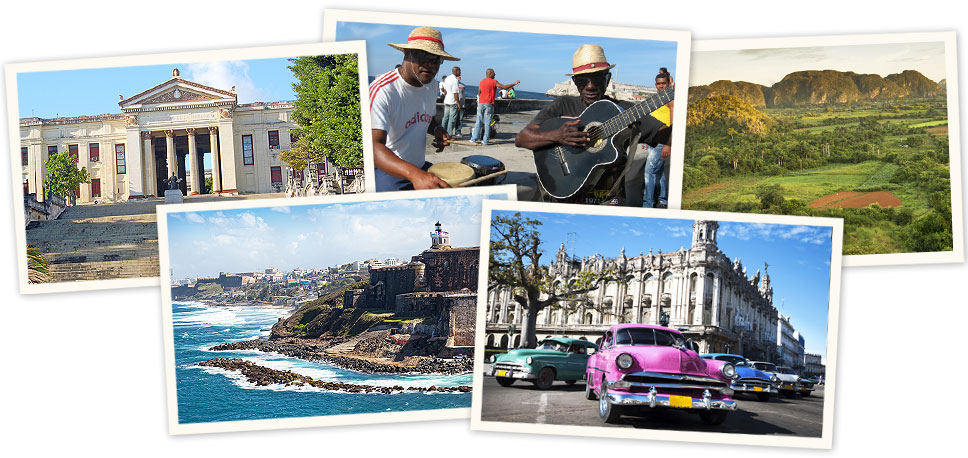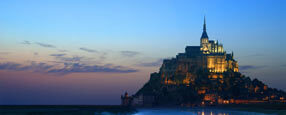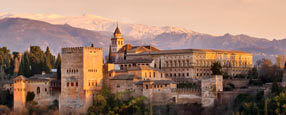CUBA TOUR with York College
Cost from: 3550 USD
Single Supplement: 730 USD
ITINERARY IN BRIEF
Welcome to Cuba! We will be met at Havana airport by our guide and driver who will escort us to our accommodation for the night.
Depending on the arrival flight, visit to the Núñez Jimenez Foundation, a Cuban cultural and scientific non-governmental institution, dedicated to research and promotion of programs projects for the protection of the environment as it relates to culture and society.
OUR GUIDING PRINCIPLES ON THIS JOURNEY IN SUPPORT OF THE CUBAN PEOPLE
Over the next two weeks, we will be immersing ourselves in all aspects of modern Cuban life, through connections with the Cuban people and places as we explore with a full-time leader and the invaluable assistance and insight as provided by a local Cuban guide. Our purpose on this special journey is educational and inspirational; we are confident that you will come away with a much better understanding of this country's unique cultural, artistic, political, natural and historical attributes, as well as its unique challenges going forward as a proudly- independent 21st Century nation state.
Overnight in Havana (Casa Particular)
Meals Included: Dinner, if required.
We will set off in classic 1950s American cars to get an overview of the city before exploring the Old Town on foot. We will visit the well-to-do Miramar district, home to the citys foreign diplomats and some of Havanas most striking modern architecture to include the imposing Russian Embassy. We will drive through the beautiful residential district of Vedado where wealthy sugar barons built elegant mansions in the early 20th century and stop in Revolution Square where Fidel made his famous speeches. Driving back along the picturesque coast road (the Malecon), the classic cars will drop us off in the Old Town in time for lunch.
After lunch enjoy a walking tour of Havana, Cuba's capital and the largest city in the Caribbean. Havana is the finest surviving Spanish colonial complex in the Americas and the seventh town Diego Velazquez founded in Cuba in the 16th century. Post-revolution restoration work and the millions of dollars invested since it was declared a UNESCO world heritage site in 1982 mean that Old Havana has been well-preserved and is often referred to as a living museum. We also enjoy an afternoon one-on-one Salsa class at a Cuban project.
Day Summary: This is an important day of introduction in the capital. We will learn much about Cuba's history, pre- and post-Columbian, with much emphasis on the Revolution and independence from Spain. We'll also enjoy the city's colourful and rich architecture, and encounter many friendly locals as we move through on our tour by bus and foot. As throughout this tour, if possible, we will do our best to enjoy our evening meals prepared by home-run restaurants and interact with the family-operators and other patrons.
Overnight in Havana.
Meals Included: Breakfast and dinner.
Today we travel to Sancti Spiritus, stopping on the way to visit Santa Clara. The provincial capital of Villa Clara province in central Cuba. The city of Santa Clara was founded in 1689 by settlers fleeing the coast and constant lootings by pirates. Today Santa Clara is an important university town but its best known for the historic events that surround revolutionist Che Guevara. Che led his rebel forces in the battle of Santa Clara, a decisive victory over Batista's army that resulted in the triumph of the revolution. Ches remains were brought here from Bolivia in 1997 and are kept in an impressive mausoleum. Visit to the Ernesto Che Guevara Memorial and the Armored Train.
From Santa Clara we continue south-east to Sancti Spiritus, the provincial capital and one of the first seven villages founded by the Spanish in the early 16th century. This is a quiet, parochial place steeped in history. Its inhabitants are proud of the Iglesi Parroquial Mayor del Espiritu Santo; the oldest operational church on the island, as well as Puente Yayabo, the only European-style redbrick bridge in Cuba.
We will also have the opportunity to visit the Guayabera Shirt Museum. The guayabera shirt was supposedly 'invented' in Sancti Spíritus by the wives of agricultural workers who sewed the trademark pockets into the garments so that their men could safely store their tools and packed lunches. This museum honors the iconic shirts displaying guayaberas worn by Hugo Chávez, Gabriel Garcia Márquez, and Fidel.
Day Summary: A full day of travel and sightseeing. An important ongoing theme will be touched upon again with respect to anti-colonial history and historical figures, notably General Antonio Maceo y Grajales. Few other Cubans have been worthy of the profound and genuine recognition he earned for himself as the leader of Cubas most epic anti-colonial struggles. Maceo was oft-referred to as the Bronze Titan because of his skin colour and his heroism in daring military campaigns. There is a plaza in his name here, as well as for Ignacio Agramonte y Loynáz, a Cuban revolutionary who played an important part in the Ten Years' War (18681878).
Overnight in Sancti Spiritus (hotel).
Meals Included: Breakfast and dinner.
Today is a long driving day as we head to Bayamo in the east of the island. We will wake up early to visit an agromarket where locals buy fresh fruits and vegetables and also meat. After this visit we continue our journey east. We pass through agricultural towns and sugar cane plantations, learning about the importance of sugar in Cubas history.
We are heading towards the southern end of the island to Bayamo, provincial capital of Granma. This is one of the island's most important regions from a revolutionary point of view and consisting mainly of the floodplain of the river Cauto (Cubs's longest).The charming city of Bayamo has a pleasant, relaxed ambiance and is full of poignant monuments and revolutionary atmosphere. It is also renowned as the birthplace of leading artists and writers and once famous for its trovadors. Women from this city are said to be the prettiest in Cuba, inspiring 'La Bayamesa,' the most famous Cuban love song.
Overnight in Bayamo (hotel).
Meals Included: Breakfast and dinner.
Morning city tour in Bayamo, in a horse-drawn carriage. After which we transfer to Santiago de Cuba, known as the city of heroes for the important role it played in the island's Independence and Revolutionary struggles. Santiago is the second biggest city in Cuba and rivals Havana in literature, music and politics.
It's also rich in traditions and folklore and almost every street corner is wrapped in legend. Surrounded by impressive mountains that link the Sierra Maestra to the sea, Santiago is made up of hills that overlook an intensely blue bay.
We will also visit the most sacred place in Cuba, La Iglesia del Cobre, located 18 km from the city of Santiago de Cuba. It houses the icon of Señora de la Caridad, Cuba's patron saint, and is one of the holiest sanctuaries in the country.
Day Summary: Today we have the chance to learn more about the Revolution, the role religion plays in everyday Cubans' lives, as well as more about the colonial past of Cuba.
Overnight in Santiago (hotel).
Meals Included: Breakfast and dinner.
Today we will visit the best sights in the area including the Santa Ifigenia Cemetery, resting place of such notable Cubans as José Martí, whose mausoleum is guarded by three Cuban soldiers at the entrance. Cuban leader Fidel Castro's ashes are also buried here. Visit to Moncada Barracks and El Morro fortress.
Overnight in Santiago.
Meals Included: Breakfast and dinner.
This morning we head towards Camaguey, capital of the province and one of the first seven towns Diego Velázquez founded in Cuba in the first half of the 16th century. Its colonial centre, which we will visit on a Bici-Taxi, is a UNESCO World Heritage site, with its labyrinthine streets that were designed to confuse the corsairs who had previously terrorized the town. This area is also famous for the large earthen jugs (tinajones) in squares, churches and gardens, which were originally used to store water during periods of drought.
Overnight in Camaguey (hotel).
Meals Included: Breakfast and dinner.
Transfer to Trinidad, the jewel in Cuba's patrimonial crown. Named UNESCO World Heritage site in 1988, Trinidads collection of beautifully-preserved colonial buildings have the Sierra del Escambray as a backdrop and overlook the Caribbean Sea. Much of the city's fortune was made during the sugar boom of the early 19th century when the citys nucleus of elegant mansions was built.
Trinidad is best explored on foot, following its winding cobbled streets to open market places where innovative locals sell artisanal goods, from hand-woven tablecloths to pottery. We also visit to the Mirador Valle de los Ingenios, the Monaca Iznaga tower, and La Casa Crochet.
There are many interesting museums to visit in the daytime, but it is as the sun sets that Trinidad really comes to life. We recommend a visit to Casa de la Trova for traditional Cuban music and dancing.
Day Summary: As the region and Trinidad is a popular tourist destination, we will also witness and learn more about the tourist industry, from large all-inclusive sun-and-style resorts to casas particulares, and the trickle down effect (or lack thereof) for people working in related businesses. We also hope to experience one of the most important unifying aspects of Cuban life music!
Overnight in Trinidad (Casas Particulares).
Meals Included: Breakfast and dinner.
Today we visit the best sights in the area. Trinidad combines the best of Cuban culture and nature in one place; nestled between the Sierra Escambray Mountains and the Caribbean coast, there are stunning views from virtually every angle; the 8km Playa Ancon white sandy beach is a 15 minute drive from the town centre and in the evenings the town comes alive with live music played in the many mainly open-air bars and restaurants centred around the towns two main squares.
Trinidad itself is a small colonial town full of charm, handicrafts markets, and paladars (private restaurants). Spend a morning wandering around and be sure to visit Casa Cantero to see a sugar barons former home.
Day Summary: This is a relatively easy-going day, with sightseeing town-based and concentrating on matters colonial. We also have opportunities to learn more about Afro-Cuban culture and traditions, including Santeria. Originally used pejoratively by the Spanish to describe the religious/superstitious beliefs which gave more attention to the Catholic saints often in preference to Jesus Christ, Santeria now applies to the most popular Afro-Cuban religion.
Overnight in Trinidad.
Meals Included: Breakfast and dinner.
Guamuhaya Mountain Massif, the second largest range in Cuba. The area is one of the most spectacular sights in Cuba and a delight for birders and walkers. The park is surrounded by impressive tropical vegetation like Caribbean pines, ancient tree ferns, bamboo, and eucalyptus. Those mountains are home to picturesque isolated rural communities dedicated mainly to cultivate coffee.
We continue on to the magical city of Cienfuegos, commonly referred to as "Pearl of the South". It is a still bearing the style brought by French colonists that founded the city in 1819. Discover the charm of the old city with its grand structures surrounding the central square, declared UNESCO World Heritage site in 2005.
Today we enjoy a Centinelas del Rio Melodioso Mountain Trek, a walk in Topes de Collantes Mountains Guanayara (5km return/medium difficulty), the least accessible but by far the most rewarding hike from Topes de Collantes. The trail itself begins in cool, moist coffee plantations and descends steeply to El Rocio waterfall. Following the course of the Río Melodioso (Melodic River), you pass another inviting waterfall and swimming pool before emerging into the salubrious gardens of the riverside Casa la Gallega, a traditional rural hacienda where a light lunch is organized.
Day Summary: A full but interesting day with themes touching on Cuba's ethnic diversity and the area's significance re the Revolution and local heroes. Cuba is far from homogenous in terms of ancestral origin, and the country's many regions reflect this in their myriad unique customs and traditions, art forms, belief systems, sports of interest, and physical appearance. We'll learn about indigenous peoples of Cuba and notice the distinct Caribbean vibe of the place.
Overnight in Cienfuegos (Casas Particulares).
Meals Included: Breakfast, lunch and dinner.
Departure to Viñales via Playa Giron, a beach on the Bay of Pigs in Zapata Peninsula. The Bay of Pigs was the site of the failed US invasion of 1961, when CIA-backed Cuban exiles tried to overthrow Castro's government. We visit the Bay of the Zapata Peninsula, the largest wetlands in the insular Caribbean and home to abundant plant and wildlife, earning its status as one of the six UNESCO Biosphere Reserves in Cuba. We will visit the Korimacao Community Project, an attempt to provide community art, music, cultural training free of charge to young artists in Cuba to preserve Cuban cultural heritage of music, dance, culture and art.
After stopping at the beach we continue to Viñales in Cuba's western-most province, Pinar del Rio. The valley is famous for its mogotes, or karsts -- rounded mountains that seem to bubble out of the ground. This striking phenomenon dates back to the Jurassic Period when the area was a cave system that collapsed, leaving steep walls that turned into these unique mountains. This epic landscape also happens to be where the best tobacco in the world is lovingly grown.
Day summary: Our educational content is strong today, with ongoing emphasis on local economies, crops and the processing and sale thereof, pre- and post-Revolution life, and small-scale market and subsistence family-farming. As our day progresses, we'll have opportunities to interact with people working in these various fields and learn about their everyday lives.
Overnight in Vinales (Casas Particulares).
Meals Included: Breakfast, lunch and dinner.
Departure to Havana, Cuba's capital. Havana is the finest surviving Spanish colonial complex in the Americas and the seventh town Diego Velazquez founded in Cuba in the 16th century. Post-revolution restoration work and the millions of dollars invested since it was declared a UNESCO world heritage site in 1982 mean that Old Havana has been well-preserved and is often referred to as a living museum. The many marvelous monuments, cathedrals, and palaces of the citys historical centre are brought to life by a constant hustle and bustle.
In the late afternoon we will visit a CDR (Comité de Defensa de la Revolución). There is one in every neighborhood and their purpose is to defend the achievements of Cuban Revolution.
Overnight in Havana (Casa Particular).
Meals Included: Breakfast and dinner.
This morning we explore the grounds of the grand and storied University of Havana, an educational campus in the Vedado area. With neo-classical architecture, the University of Havana was built in 1902, and the bronze Alma Mater statue was created by artist Mario Korbel in 1919.
The afternoon we will continue to explore Havana and discover the charm of the city and its inhabitants. There are several interesting museums, including the Museum of the Revolution, housed in an impressive building that served as the Presidential Palace from 1920 to 1965. The Museum of the Revolution covers Cuban history from colonial times to the incredible story of the 1959 Revolution. Nearby, the Cuban Fine Arts Museum has a fascinating collection of works from the 19th century to the present day, including pieces by internationally renowned artists with permanent collections in Europe and the US.
Day Summary: Today is the day for summation, reflection, and supposition regarding the future of this vibrant, venerable nation and its people. It is also our last chance to shop, soak in the music and colour, and enjoy the effortless, welcoming smiles on the locals' faces. This evening we enjoy a farewell dinner and likely some Cuban music to see us off.
Overnight in Havana.
Meals Included: Breakfast and dinner.
Transfer to Havana airport for your return flight.
BUEN VIAJE!
Meals Included: Breakfast.
INCLUSIONS
- Breakfast daily and some lunches and dinners per the itinerary
- Sightseeing and entrance fees
- Transportation in private vehicle
- Services of local guides
- Services of an Adventures Abroad Tour leader
- Round trip international flights from Baltimore to Havana with American Airlines
- Mandatory medical insurance from American Airlines
EXCLUSIONS
- Tuition fees
- Program fee for non-students
- All personal expenses; e.g. laundry, drinking water, beverages
- Gratuities to drivers, porters, waiters and gratuities to the Adventures Abroad tour leader will be collected before departure by Mr. Fyfe.
- Cuba Tourist card for entry - approx $50 - $80
TOUR SAFETY
Global Educational Travel has implemented new safety measures and has received the World Travel and Tourism Council's Safe Travels stamp, which provides travellers with the assurance that we have adopted health and hygiene global standardised protocols – so you can experience 'Safe Travels'.
Click here for more info
LOOKING FOR INSPIRATION?








